Editorial Note: In July 2023, Lady Freethinker sent an observer to witness a massive federal roundup of wild horses at the Antelope Complex-North in Nevada. You can read our write up about the first week of roundup, in which six horses were killed, here. What follows are excerpts from our observer’s log notes, edited lightly for style and for length, about what it was like to be out there. The roundup straddled the Nevada/Utah border and our observer’s watch synced to the Utah towers, so times below are reported in Mountain Standard Time. We have since sent a letter to authorities asking for an immediate halt of this inhumane roundup.
July 11, 2023

(Scott Henderson/Lady Freethinker Investigation)
8:08 a.m.: Day is starting off warm at 80 degrees with a very light breeze. The sun is already beating down over the open desert. Clear skies, dry air and dry ground mean every step on bare soil brings up some dust. Today’s observation point is about a mile away from the trap area. The area is hilly but not overly steep for this area though walking up any of these hills causes most people to feel the incline, especially if they have a backpack full of camera equipment. The first push from the helicopter brings in about 8 horses, with a colt that breaks away just before getting into the trap and needs to be chased down with the helicopter and pushed back as the last to enter. The horses are obviously not happy to have been pushed and now to be trapped without a place to go for the first time in their lives, as they push each other and walk back and forth along the fencing keeping them in.
9:04 a.m.: Heat is increasing. It’s about 85 degrees and the breeze isn’t helping much.

(Scott Henderson/LFT Investigation)
9:36 a.m.: It is very quiet out here until you hear the beat of helicopter blades thrashing the wind. At almost a mile away, not even audible are the sounds that the horses must be making in the trap as they wander back and forth or the yells of cowboys herding the horses with plastic bags attached to sticks that I have been told make a popping, thrashing sound that gets the horses moving… The previously wild horses file in billowing dust with their hooves, and close behind is the helicopter that hovers until the cowboys close the gate and bring out their noisemakers and begin pushing mares and foals into one area and stallions into another, keeping them separated.

(Scott Henderson/LFT Investigation)
9:47 a.m.: The rest of the horses are loaded and head out in the trailer toward the main holding area south of us; I am told it is about a 40 minute drive there. As they pull away a couple of the mares do a little biting and pushing of each other before settling in for the drive. There are no more horses waiting to be taken from the trap at this point and silence returns.
12:43 a.m.: The public affairs specialist from the BLM that has been sitting with us all day announces that she heard over the radio that they are going to shut down this trap site and that the helicopter is going out to look at where to set up the next trap site for tomorrow, as the horses have mostly moved to the north and would be farther away than the max 10 mile push that they can do.
2:12 p.m.: While looking for the new trap site, they saw a small group of horses and decided to push them in. It is hot, about 92 degrees. These pushes all seem the same: dusty, not happy horses. But no injuries, no strays.
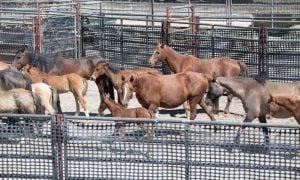
(Scott Henderson/LFT Investigation)
The BLM is trying to get 3,107 horses from this roundup from both the north and the south areas. From what I can tell this is going to take a long time and a lot of money just to gather them and get them to the holding area. Fuel for the helicopter, rental of the helicopter, Fish and Game law enforcement to maintain safety of the area, public affairs, BLM managers, horse wranglers, trucks, equipment. Does the desire to use the land for grazing justify the cost? The BLM public affairs specialist said that they haven’t been able to use this area for grazing for 10 years and the county and ranchers are fed up with waiting to be able to use the land.

(Scott Henderson/LFT Investigation)
4:01 p.m.: Arrived at the holding area. It is 90 degrees with a stiff wind blowing the dust everywhere as they corral and sort the horses. Today’s gather brought in 49 horses from the north.
July 12, 2023
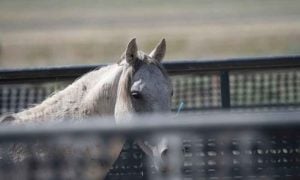
(Scott Henderson/LFT Investigation)
7:05 a.m.: Arrived at the new site, closer this time, about 0.6 of a mile away. It’s 72 degrees with no wind and clear skies. Gnats are everywhere. Near the trap site is rolling hills, but it pretty quickly goes into the more mountainous and steep area to the west, with multiple ravines and canyons that lead to this area. The first small group of horses is already in the trap. One of the observers is upset that they put the horses in the trap before we were there to observe, something about our First Amendment right and that there was already a lawsuit and they are not allowed to do anything without observers being there and able to observe. The BLM public affairs specialist explained that the horses were already right there when the wranglers showed up and they just needed to get them in there before they scattered.

(Scott Henderson/Lady Freethinker Investigation)
8:45 a.m.: A large group is being pushed in with two helicopters (we have an extra helicopter this morning as they are moving the trap down south). While pushing them in, one horse seems to have broken free to the east and two cowboys and a helicopter have headed east on the blind side of the ridge to push the horse back in. After about 10 minutes, the cowboys come back with a light tan yearling that they have roped with the help of the helicopter herding. As the helicopter leaves, silence once again drops over the area like a heavy blanket putting everything back into its place.
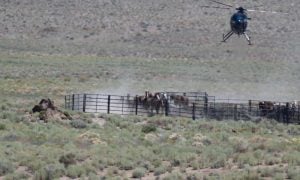
(Scott Henderson/Lady Freethinker Investigation)
10:20 a.m.: A water truck has shown up to spray the trap area and a truck with trailer has come back to pick up the last of the horses from the last push at 8:45 a.m.
10:30 a.m.: A new group is being pushed in from the SW, and they are beginning to load up the horses from the last group. The temperature is slowly climbing, and we are at about 88 degrees currently.
1:30 p.m.: We begin our walk of the holding area. Again very dusty. No injuries, no lives lost.
July 13, 2023
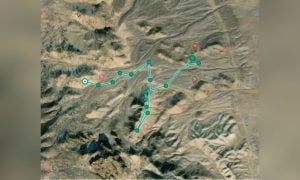
GPS coordinates showing the chase prior to the killing of the spirited, wild Palomino stallion. (Scott Henderson/LFT Investigation)
7:05 a.m.: Arrived on site to 72 degree weather and a bit of wind, about 8 MPH. Everyone is dosing with eye drops as the dry air and fine dust is a constant irritant. Even with the cooler temps and wind, the sun is still relentless.
8:23 a.m.: First group of about 10 just pushed in. It is the same every time a group comes in, the sound of a steel gate slamming shut and flapping plastic bags being waved while dust billows up around the horses, filling their noses and eyes far worse than us observers complaining about our bloodshot eyes.
9:36 a.m.: The wind has dropped off to be replaced with oppressive stillness and a temp of about 83 degrees.
10:35 a.m.: 10-12 horses were just pushed in. There is a big, tan stallion with a long white mane kicking and biting its mates.
10:39 a.m.: He makes a break over the fencing to the southwest. He tumbles, with a cloud of dust as he is coming over like he got stuck in the fence for a moment. He works his way around a large rock that is on the south side of the trap, stumbling a few times before getting his bearings and heading toward the southwest again. It quickly becomes evident that he has broken his left rear leg about a quarter of the way up. It’s a clean snap that seems like a shoe tied to the bottom of an empty pant leg just flinging loosely. As he is working his way to the southwest, he stops multiple times to look back at all of those he is leaving behind, kicks his broken leg around a few times, and continues on.
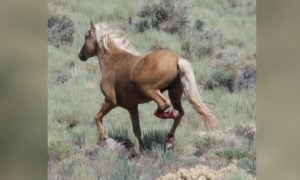
(Scott Henderson/LFT Investigation)
Continuing to the south and west and into the ravine, cowboys follow slowly (it took them a bit to start the chase as the stallion was in the mouth of the ravine before they came out) and after going into the ravine/canyon a little ways they come back out and wait. A few minutes later, the helicopter comes over to the top of the canyon and begins pushing the stallion back down to the cowboys. As the cowboys come up to meet the stallion, the stallion shows some serious spirit and just blows past the cowboys on some very steep terrain. With only three working legs, he is still avoiding and staying away from the cowboys as he comes back down to the flat area and heads almost directly west to an area that has a drop in it, with the cowboys following.
The helicopter swings around to get in front of the stallion again as they all drop down out of sight. For 3.5 to 4 miles, and closing in on an hour, this stallion has led the cowboys and helicopter in chase.
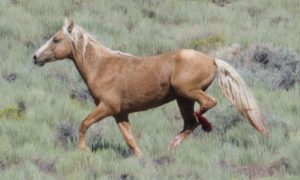
(Scott Henderson/LFT Investigation)
11:29 a.m.: A distant single gunshot rings out. Silence and wind return to the desert as though they had both left to avoid the spectacle. Silence, heat, wind. Maybe they never left, but I didn’t notice them for almost an hour. No one talks.
12:10 a.m.: The wind is still about 8-10 MPH, 85 or 86 degrees. A group is pushed in with a tan colt separated for about 10 minutes while the helicopter pushes him to the cowboys that finally bring him in on rope. Everyone is still silent.
1:00 p.m.: A small group of three is pushed in from the mountainous region directly to the west. The helicopter has been working this canyon for a while back and forth before they show up. The wind is starting to pick up.
2:39 p.m.: We packed up and headed over to the holding area.








